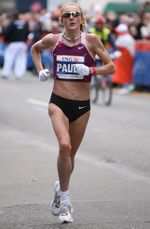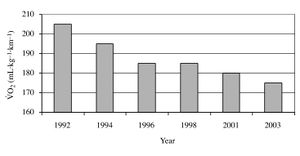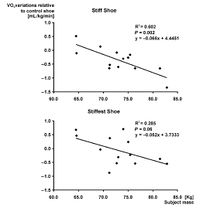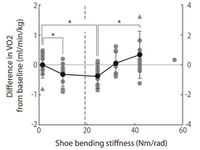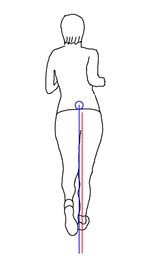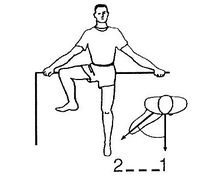The Science of Running Economy
Running Economy is how much energy it takes you to run. The better your economy, the faster and further you can run. Running economy is obviously determined to some extent by biomechanical efficiency, especially Cadence. There is some evidence that biochemical changes may have a significant impact on running economy. For instance, slow twitch Muscles require less oxygen for the same level of work as fast which muscles do, and burning fat requires more oxygen than carbohydrates.
Contents
1 Why Should You Care?
Running Economy can vary by as much as 30% between runners of a similar V̇O2max[1]. The two charts below show the V̇O2max and running economy of Paula Radcliffe over a 10 year period[2]. Over that time Paula Radcliffe's race performance dramatically improved even though her V̇O2max did not. This suggests that for elite athletes at least, improvements in running economy are critical. It's generally believed that Running Economy is more "trainable" than V̇O2max in athletes that have been training for years[3].
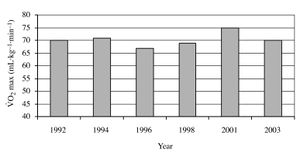 Paula Radcliffe's V̇O2max |
2 Shoes
The research on how shoes effect running economy is rather confusing, with many apparently contradictory findings in some areas. Some of the problems include:
- Many studies use a treadmill, which may have some level of cushioning built in. This has an obvious and profound effect on studies that are looking at how cushioned and un-cushioned footwear or barefoot running change running economy.
- Few studies controlled for Cadence or Foot Strike, and barefoot has lower ground contact time[4][5][6], and a higher cadence[4][6] than shod.
- The type of shoe, especially the raised heel may also influence outcome.
2.1 Shoe Weight
Studies have consistently shown that heavier shoes reduce running economy[7][8][9][10]. Each 100g/3.5oz added to the weight of each shoe reduces running economy by about 1%[11][10][12][13].
2.2 Shoe Cushioning
The results of studies that have compared barefoot and shod running (or running in un-cushioned and cushioned shoes) have provided conflicting information. Some studies show that running economy is worse when wearing shoes, with the bulk of the detrimental effect explained by the shoe weight. However, other studies have shown that the cushioning provided by shoes can compensate for the reduction in running economy due to shoe weight, and sometimes the shoes can actually be provide better economy than barefoot. I believe that the key to understanding this conflict lies in the type of running a surface that is used by the study. Not surprisingly, if a study uses a cushioned treadmill, the cushioning provided by the shoe does not confer any additional advantage over the barefoot condition. Of the 11 studies I found, 3 of the 4 studies using cushioned treadmills showed no improvement in running economy for shoe cushioning, while the 4 studies using un-cushioned treadmills and one using a cushioned treadmill showed an improvement for shoe cushioning. There were three studies that did not give sufficient information to determine the type of treadmill, and two showed no improvement while the remainder did. I conclude that a well cushioned running shoe can improve Running Economy by an estimated 2-3.5% compared with a weight matched un-cushioned shoe. In practice, most shoes will have a beneficial impact on Running Economy due to cushioning and a negative impact due to their weight.
2.2.1 Studies on cushioned treadmills
Most studies tend to use cushioned treadmills, as these are the most commonly available.
- A thesis study showed that barefoot is more economic than shoed (New Balance M1500, 344-368g/shoe), but the same as shod when compensating for shoe mass[14]. The barefoot condition had a greater Cadence than shod. The treadmill (Marquette model 1900) was cushioned.
- Habitually FFS runners are 2.4% more efficient in minimally shod (FiveFingers with) than cushioned (GEL-Cumulus 10) shoes at 9 min/mile pace and with weights to ensure equal mass[15]. This study used a Vision T9250 treadmill that is cushioned, with a reputable reviewer rating as 6.8/10 for cushioning[16].
- A study compared barefoot (BFT), minimally shod (MS), and shod (SH) showed that BFT was 2.6-5.1% more efficient than SH[17]. The study also compared MS at the Cadence of BFT (165) and the cadence of SH (160), with an improvement only seen at the lower cadence. The participants had no prior barefoot or minimal running experience, and no adjustment was made for shoe mass. However, this study used a Woodway PPS treadmill with the manufacture claim that "Our patented Slat Belt running surface helps absorbs more of the impact than any other treadmill([18])".
- A study comparing barefoot running with the participants using their normal running shoes showed that barefoot condition had a 4.4% improvement in running economy[19]. However, 80% of the change in running economy could be explained by shoe mass. In fact, the slope of the line between shoe mass and running economy predicts that a shoe weighing 9.2oz/260g would have the same running economy has barefoot. The shoes used weighed between 8.5-15oz (239-430g). Interestingly while running economy improved, V̇O2max did not. The treadmill used was a WoodWay Pro-XL, a highly cushioned "slatted" treadmill similar to the one noted above.

2.2.2 Studies on un-cushioned treadmills
- Running in lightweight (150g/5.3oz, Nike Mayfly) shoes was 2% more efficient than barefoot[11]. The study used runners with a midfoot Foot Strike and an un-cushioned treadmill (Quinton 1860).
- A thesis study showed that running in lightweight shoes (Nike Mayfly) was 3.4% more efficient than weight matched barefoot, and 2.1% more efficient than barefoot[10]. The study used runners with a midfoot Foot Strike and an un-cushioned treadmill (Quinton 1860). When the weight of the Nike Mayfly shoes was doubled using weights, the running economy was still better than barefoot. The study also added EVA foam to the treadmill surface, but this did not change the running economy of barefoot running. However, the cushioning was added in slabs, and participants noted that the gaps felt "like running on a trail".
- Running barefoot and in Nike 3.0 shoes had no difference in running economy on an un-cushioned treadmill (Quinton 1860)[20]. However, adding 10mm of cushioning to the treadmill improved barefoot running economy by 1.9%[20]. Using 20mm cushioning made no further improvement over 10mm. The cushioning was provided by EVA foam used in running shoes. (The EVA foam was fairly soft, measuring 52-58 on the Asker Type C scale[21]. That's about 27-33 on the Shore A scale.)
- A comparison of barefoot and shoes weighing 150g and 350g showed the same running economy in barefoot and 150g shoes, but 3.6% lower running economy in 350g shoes[22]. The treadmill used (ADAL 3D, HEF-Tecmachine) appears to be un-cushioned. This study also showed that compared with barefoot, shoes reduced the total energy required to run (work) without changing V̇O[22], suggesting that barefoot is using more elastic energy, further suggesting that the barefoot condition in this study uses forefoot strike[23].
2.2.3 Unknown Treadmill
Sadly, many studies don't explicitly state the type of treadmill used.
- Barefoot was 2.0% more economic than shod on a treadmill and 5.7% more economic on an indoor track[24]. However, the type of treadmill and indoor track was not described and may have been cushioned. No indication was given of the type or weight of the shoes used.
- Barefoot was 1.3% more efficient than running in 340g shoes, while Vibram FiveFingers was 2.8% more efficient[6]. The Cadence was 91.2 barefoot, 88.3 in FiveFingers, and 86.0 in shoes. While it seems strange that the FiveFingers were more efficient than barefoot, I suspect this is likely to be a statistical anomaly due to the small sample size (8 runners). The runners were all experienced in barefoot running. It is unclear if the Zebris FDM-T treadmill is cushioned or not.
- A study using Nike Air shoes showed an average 2.4% improvement in running economy compared with firmer shoes of a similar weight[25]. The improvement in running the economy varied by individual, between 0.5% and 6%, SD=1.8%. No details of the type of treadmill used were recorded.
2.3 Heel Rise (drop)
The typical running shoe has a sole that is around 10mm thicker at the heel than the forefoot, something that is typically called "drop" or "pitch". Currently the available research in this area is extremely limited.
- A study looked at the running economy of Newton running shoes that have "actuator lugs" on the forefoot[26]. The study used identical shoes as controls with the lugs removed. The control shoes were slightly lighter (0.5oz/15g), and had 5mm more drop. The subjects were 12 highly trained male runners, 5 with a midfoot strike, and 7 with a rear foot strike. The study found that the actuator lugs resulted in a ~1% improvement in running economy, even though the shoes were slightly heavier. The improvement could be due to the additional forefoot cushioning, the reduced drop, or something specific to the forefoot cushioning in the actuator lugs. (Having run in Newton shoes, the forefoot cushioning does not feel any different to other cushioning systems, though the lack of material under the toes does change the final push off.)
- An undergraduate thesis showed no difference in running economy with subjects wearing shoes with 0mm drop, 4mm drop, and their usual running shoes (12-14mm)[27].
- In one of the more bizarre bits of research, a comparison of running shoes and stiletto high heeled dress shoes (4.5cm and 7cm heels) showed that the running shoes were more economic[28].
2.4 Flexibility
There is some evidence that less flexible shoe may improve running economy[29][30]. However, there appears to be a "Goldilocks effect" where a little bit of additional flexibility improves running economy, but too much will actually have the opposite effect. It also appears that the amount of stiffness that is "just right" varies considerably from runner to runner, though this may be related to the runner's weight with heavier runners benefiting more. Converting the stiffness used in the studies to ordinary running shoes is not clear, and the two studies use different methods for measuring the stiffness. More importantly, the stiffer shoes were not because of thicker foam or more rubber outsole, which are the normal causes of inflexibility, but the addition of carbon fiber plates to highly flexible shoes. These carbon fiber plates are likely to be far more springy than typical inflexible running shoes. The first study used the Adidas Adistar Comp and compared it with modifications that increased the stiffness by 2.0x or 2.5x. In the graphs below you can see that the lighter runners have reduced running economy with stiffer shoes, while heavier runners do much better. However, even for a given weight, there is still wide variation.
The second study used the Reebok ZQuick which has a grooved sole to improve flexibility as its baseline, and then modified the shoes with various thickness carbon fiber plates. The ZQuick had a stiffness of only 1.5 Nm/rad, and the plates increased this to 10, 25, 32, and 42 Nm/rad (one runner tried a plate with 57 Nm/rad). The test shows a clearer sweet spot or goldilocks zone with the moderate thickness plates. For all the plates, there were some runners that did worse than in the bare shoes, and some runners that did better in even the thickest plate.
2.5 Other Shoe Characteristics
There are a handful of studies that have looked at other shoe characteristics, there is insufficient information to reach any conclusions.
- A study has suggested that shoe comfort affects running economy, with the most comfortable shoes having the greatest economy[31], but due to the many differences in the shoes used, the study seems too flawed to be of much use.
- A comparison of identical shoes, one made with EVA foam and the other with Adidas' softer "Boost" foam indicated that the softer foam had a 1% better running economy[32].
3 Fatigue
A short (30 minute) high intensity run does not change economy[33], but economy deteriorates during a marathon run, possibly due to muscle damage and the need for greater neurological muscle activation to produce the force required to maintain pace[34]. However, a marathon run does not significantly change running biomechanics such as ground contact time[35].
4 Glycogen depletion & Fat Burning
Because burning fat requires more oxygen than carbohydrate, the switch to fat burning due to Glycogen Depletion means more oxygen is required. This does not directly change running economy if it's measured as power output, but it does if it does increase the percentage of V̇O2max which is often how Running Economy is evaluated[34]. However, breathing rate becomes higher to supply the required oxygen, and the amount of oxygen extracted in each breath is lower, further driving the breathing rate.
5 Running Biomechanics
There are a number of biomechanical features of running that are relatively easily measured that may impact Running Economy.
5.1 Cadence
A review of the scientific studies showed consistently that an increased Cadence reduces shock at the hip, knee, and ankle, vertical oscillation, and ground contact time[36]. One study calculated that Cadence is 28% of the variation due to biomechanical differences[37].
5.2 Balance and step width
Maintaining side to side balance is estimated to cost 2% of the energy of running[38]. This may be due to step width, as increasing step width can reduce running economy by 11%[39].
5.3 Arm Swing
While it obviously costs energy to swing the arms while running, this arm swing actually improves running economy[38][39], probably by improving balance.
5.4 Ground Contact Time
It's a generally believed that the less time a runner spends in contact with the ground, the more efficient they are. However, the scientific evidence is a little patchy.
- Two studies found that a shorter Ground Contact Time was indeed correlated with better Running Economy[40][41]
- Plyometric training for 9 weeks improved 5K times, improved running economy and reduced Ground Contact Time[42]. It's unclear if the reduced Ground Contact Time was part of the improvement in either 5K time or running economy, but it is suggestive.
- Two studies found no relationship between Ground Contact Time and Running Economy[43][37].
- One study found that a longer Ground Contact Time is correlated to a better Running Economy, the opposite of what is generally expected[44]. However, that study measured Running Economy at 3.9 m/s (6:50 min/mile), and the correlation with longer Ground Contact Time was only seen at speeds between 5.8-6.6 m/s (4:37-4:04 min/mile), rather radically faster.
- Running to exhaustion may increase Ground Contact Time[45]. This may not tell us much about Running Economy, but it's possible that Ground Contact Time might be an indirect measure of fatigue.
- In a wide range of animals, from a 32g kangaroo rat to a 140Kg pony, the energy cost of running has been shown to be proportional to the time each foot spends in contact with the ground[46]. This suggests that the energy taken to run is mostly taken with supporting the weight of the body.
5.5 Vertical Oscillation
It seems obvious that greater Vertical Oscillation is going to be less efficient, but the research is not there to support this. One study noted "The intuitive perception is that oscillation is adversely related to economy" but found no supporting research[47].
- Greater vertical impulse on a force plate related to lower RE but noted exceptions to this seem common[43].
- In 16 national level runners, greater Vertical Oscillation was associated with improved Running Economy, the opposite of what would be expected[37]. The study found that Vertical Oscillation accounted for 7% of the variation due to biomechanical differences.
- A 1997 study found elite runners have less Vertical Oscillation than sub-elite runners[48].
- Running with exaggerated Vertical Oscillation reduces Running Economy[49]. This suggests that it's possible to use excessive bounce to intentionally compromise your running, and might indicate that some runners could have a problematic level of Vertical Oscillation, but there is no clear evidence to indicate that's the case.
- A study of 31 runners found that there was a non-significant relationship between increased Vertical Oscillation and reduced Running Economy, with the most economic runners having a Vertical Oscillation of 9.1cm and the least economic having 9.6cm[50].
- Running to exhaustion may increase Vertical Oscillation[45], which might make Vertical Oscillation a metric for evaluating fatigue.
- Vertical Oscillation tends to decrease with increased Cadence[51]. This makes perfect sense from a simplistic model of running, as a higher cadence means that each stride is shorter, so less time is spent in the air where the runner is in a ballistic curve. This relationship can confuse the analysis of Running Economy, as it's easy to attribute changes in Cadence to Vertical Oscillation, or Ground Contact Time.
- Feedback to reduce Vertical Oscillation resulted in impaired Running Economy[51]. The study used real-time feedback to encourage runners to reduce their Vertical Oscillation, but the study lasted a relatively short time. It's possible that the impaired Running Economy was a result of the initial change in biomechanics rather than indicating that reduced Vertical Oscillation is actually a bad thing. Of course, the other interpretation is that there is an optimal level of Vertical Oscillation and attempting to reduce it is actually a bad thing.
5.6 Braking
Another intuitively obvious factor in running economy is breaking. After all, anything that slows a runner seems likely to reduce their running economy. There are three obvious places to measure breaking; the foot, the ground, and the body. A runner's foot has to decelerate so that there is no horizontal movement when it's in contact with the ground, and then accelerate to be faster than the body to move ahead for the next footfall. If the foot has decelerated so that there is no horizontal movement prior to the footfall, then you'd expect no braking force to be detected in the ground, whereas if the foot is still moving forward, there would be a braking force detected. The third place to measure breaking is the body (or center of mass), which may also vary in horizontal velocity. It seems a reasonable that variations in horizontal velocity of the body would reduce running economy.
- A study of 17 runners found that the braking force detected on the ground explained most of the variation in running economy[52].
- A study of 11 elite runners found that there was a statistically significant correlation between the sum of the peak horizontal and vertical forces and running economy, with lower forces being more economical[53]. However, the study did report on horizontal forces alone, or the total energy involved in the breaking.
I've not found any research covering braking forces on the body, which would seem to be a natural subject of inquiry.
5.7 Foot strike
It's often assumed that a forefoot landing is more efficient than a rear foot landing, but there's no clear evidence to support that.
- A study found that while there was no difference in Running Economy between different foot strike types, there was a higher work produced with Forefoot Strike, suggesting more elastic storage[23].
- A study looked at runners with different foot strike patterns and compared them running with their habitual stride and intentionally modifying to an alternative foot strike[54]. The study found no differences with the exception of rear foot strike runners changing to a forefoot strike.
- Sub-elite rear foot strike runners are more economic than midfoot strike, and while a cadence was the same the rearfoot runners had a higher Ground Contact Time[55].
6 Plyometrics & Heavy Weight Training
A 2017 meta-analysis found that plyometrics and heavy weight training improved running economy by ~3.9%[56]. Both interventions were similar in their improvement, with plyometrics having ~4.8% and heavy weight training ~3.7%. The benefits increased with training duration, with some benefit after 6-8 weeks and moderate-to-large benefits after 12-14 weeks. The vast majority of the studies used 2 or 3 training sessions per week, which makes sense given these are in addition to regular endurance training. Plyometrics are high speed movements, such as jumps, that combing rapid landing and push off (eccentric and concentric) forces[57]. The plyometrics used in the running economy studies were jumps, squat jumps, drop jumps, hops, bounds, and sprints. Heavy weight training was defined as 10 or less repetitions at 70+% of 1 repetition maximum. The weight training used predominantly leg press and squats. As well as long term plyometrics, there's some suggestions that a warmup involving plyometrics could improve running economy in the following run[58]. The study used 2 sets of 8 repetitions of each of squat jumps, scissor jumps, and double leg bounds. I believe the mechanisms for both plyometrics and heavy weight training are similar, with both approaches recruiting all muscle fibers. There are no scientifically based recommendations for the structure or progression of plyometric training[59], but my thoughts are at Plyometrics.
7 Body weight and fat percentage
The relationships between body weight, body fat, and running economy are not what you might expect.
- Body Mass. Greater body mass is associated with better running economy[60][61]. This may be because larger individuals can store more elastic energy on each step to reduce their energy consumption[62].
- Body Fat. Perhaps surprisingly, obese individuals have similar running economy as leaner individuals[62]. Remember that running economy is energy used divided by weight. So the heavier you are, the more energy required overall, and more body fat results in a lower power output. So being overweight reduces your fitness (aerobic capacity) but not your running economy.
8 DOMS
Delayed Onset Muscle Soreness reduces running economy[63][64]. This matches most runners experience, as it's tough to run with DOMS. My personal suspicion is that DOMS damages the muscle fibers that are used first, and these fibers are the most trained and the most efficient.
9 Flexibility
Greater flexibility reduces running economy. Runners with greater standing external hip rotation and dorsiflexion of the foot have poorer running economy[65]. (Dorsiflexion of the foot is bending the ankle so the toes move towards the shin, which is what happens when you do a calf stretch. Standing External Hip Rotation is shown above.) Another study showed that greater overall flexibility is associated with poorer economy, with the most flexible third of the studied group using 9% more energy than the least flexible third[66].
- Stretching Programs. Most studies show that Stretching programs do not reduce running economy[67][68].
- Stretching before running. One study[69] has shown that stretching directly before running reduces performance and running economy, but most studies indicate no impact[70][71], even though the stretching impairs other muscular functioning. (One study on subjects with limited hip range of motion showed that stretching before running improved running economy[72], but the subjects were only tested with 4 minutes of running, and a steady state requires 4-15 minutes[73]).
10 Gender
Women may improve their running economy in response to training more effectively than men[60].
11 Height
In elite runners, being taller was correlated with being less economic[53].
12 Muscle Fiber Types
Fast twitch Muscle fibers require more energy to provide contraction than slow twitch muscles[74][75][76], so a runner with a higher proportion of slow twitch fibers will have better running economy.
13 Magnesium
14 Framework for Factors Effecting Running Economy
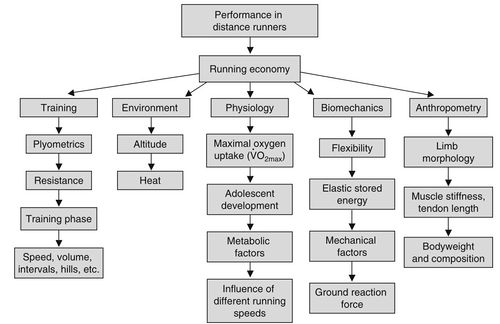
15 Concerns with Measuring Running Economy
Most studies use Oxygen use as a proxy for energy use, but this is not always accurate[79]. Measuring Running Economy is reasonably repeatable, with a Coefficient of Variability of ~1-2%, though these variations are sufficient to cause issues in determining changes in economy due to different situations[80].
16 References
- ↑ JT. Daniels, A physiologist's view of running economy., Med Sci Sports Exerc, volume 17, issue 3, pages 332-8, Jun 1985, PMID 3894870
- ↑ Andrew M. Jones, The Physiology of the World Record Holder for the Women's Marathon, International journal of Sports Science and Coaching, volume 1, issue 2, 2006, pages 101–116, ISSN 1747-9541, doi 10.1260/174795406777641258
- ↑ Isabel S. Moore, Is There an Economical Running Technique? A Review of Modifiable Biomechanical Factors Affecting Running Economy, Sports Medicine, volume 46, issue 6, 2016, pages 793–807, ISSN 0112-1642, doi 10.1007/s40279-016-0474-4
- ↑ 4.0 4.1 C. Divert, G. Mornieux, H. Baur, F. Mayer, A. Belli, Mechanical comparison of barefoot and shod running., Int J Sports Med, volume 26, issue 7, pages 593-8, Sep 2005, doi 10.1055/s-2004-821327, PMID 16195994
- ↑ EB. Lohman, KS. Balan Sackiriyas, RW. Swen, A comparison of the spatiotemporal parameters, kinematics, and biomechanics between shod, unshod, and minimally supported running as compared to walking., Phys Ther Sport, volume 12, issue 4, pages 151-63, Nov 2011, doi 10.1016/j.ptsp.2011.09.004, PMID 22085708
- ↑ 6.0 6.1 6.2 R. Squadrone, C. Gallozzi, Biomechanical and physiological comparison of barefoot and two shod conditions in experienced barefoot runners., J Sports Med Phys Fitness, volume 49, issue 1, pages 6-13, Mar 2009, PMID 19188889
- ↑ T. Lussiana, N. Fabre, K. Hébert-Losier, L. Mourot, Effect of slope and footwear on running economy and kinematics, Scandinavian Journal of Medicine & Science in Sports, volume 23, issue 4, 2013, pages e246–e253, ISSN 09057188, doi 10.1111/sms.12057
- ↑ LN. Burkett, WM. Kohrt, R. Buchbinder, Effects of shoes and foot orthotics on VO2 and selected frontal plane knee kinematics., Med Sci Sports Exerc, volume 17, issue 1, pages 158-63, Feb 1985, PMID 3982270
- ↑ S. Sobhani, S. Bredeweg, R. Dekker, B. Kluitenberg, E. van den Heuvel, J. Hijmans, K. Postema, Rocker shoe, minimalist shoe, and standard running shoe: a comparison of running economy., J Sci Med Sport, volume 17, issue 3, pages 312-6, May 2014, doi 10.1016/j.jsams.2013.04.015, PMID 23711621
- ↑ 10.0 10.1 10.2 The separate effects of shoe mass and cushioning on the energetic cost of barefoot vs. shod running. Wierzbinski, Corbyn. University of Colorado at Boulder. Departmental Honors Thesis. http://digitool.library.colostate.edu///exlibris/dtl/d3_1/apache_media/L2V4bGlicmlzL2R0bC9kM18xL2FwYWNoZV9tZWRpYS8xMTkyODM=.pdf
- ↑ 11.0 11.1 JR. Franz, CM. Wierzbinski, R. Kram, Metabolic cost of running barefoot versus shod: is lighter better?, Med Sci Sports Exerc, volume 44, issue 8, pages 1519-25, Aug 2012, doi 10.1249/MSS.0b013e3182514a88, PMID 22367745
- ↑ Frederick , E. C. The energy cost of load carriage on the feet during running. In: Winter, D.A., R. W. Norman, R. P. Wells, K. C. Hayes, and A. E. Patla (Editors), Biomechanics IX-B Human Kinetics Publ., Champaign, IL, pp.295-300, 1985
- ↑ Frederick, E. C., Physiological and ergonomics factors in running shoe design. Applied Ergonomics 15(4): 281-287, 1984
- ↑ Flaherty R F. Running economy and kinematic differences among running with the foot shod, with the foot bare, and with the bare foot equated for weight [Thesis] . Springfield (MA): Springfi eld College 1994 ; 106
- ↑ DP. Perl, AI. Daoud, DE. Lieberman, Effects of footwear and strike type on running economy., Med Sci Sports Exerc, volume 44, issue 7, pages 1335-43, Jul 2012, doi 10.1249/MSS.0b013e318247989e, PMID 22217565
- ↑ Vision T9250 Deluxe Treadmill Review, http://www.treadmilldoctor.com/vision-t9250-deluxe-treadmill-review-09, Accessed on 19 October 2014
- ↑ Isabel Sarah Moore, Andrew Jones, Sharon Dixon, The pursuit of improved running performance: Can changes in cushioning and somatosensory feedback influence running economy and injury risk?, Footwear Science, volume 6, issue 1, 2014, pages 1–11, ISSN 1942-4280, doi 10.1080/19424280.2013.873487
- ↑ WOODWAY PPS Ultimate Medical Treadmill, http://medical.woodway.com/cardiac_rehab/cardiac_rehab_pps.html, Accessed on 19 October 2014
- ↑ 19.0 19.1 KA. Reeves, J. Corbett, MJ. Barwood, Barefoot running improves economy at high intensities and peak treadmill velocity., J Sports Med Phys Fitness, Jul 2014, PMID 24998616
- ↑ 20.0 20.1 KD. Tung, JR. Franz, R. Kram, A test of the metabolic cost of cushioning hypothesis during unshod and shod running., Med Sci Sports Exerc, volume 46, issue 2, pages 324-9, Feb 2014, doi 10.1249/MSS.0b013e3182a63b81, PMID 24441213
- ↑ From email communication with Kryztopher D. Tung.
- ↑ 22.0 22.1 C. Divert, G. Mornieux, P. Freychat, L. Baly, F. Mayer, A. Belli, Barefoot-shod running differences: shoe or mass effect?, Int J Sports Med, volume 29, issue 6, pages 512-8, Jun 2008, doi 10.1055/s-2007-989233, PMID 18027308
- ↑ 23.0 23.1 LP. Ardigò, C. Lafortuna, AE. Minetti, P. Mognoni, F. Saibene, Metabolic and mechanical aspects of foot landing type, forefoot and rearfoot strike, in human running., Acta Physiol Scand, volume 155, issue 1, pages 17-22, Sep 1995, doi 10.1111/j.1748-1716.1995.tb09943.x, PMID 8553873
- ↑ NJ. Hanson, K. Berg, P. Deka, JR. Meendering, C. Ryan, Oxygen cost of running barefoot vs. running shod., Int J Sports Med, volume 32, issue 6, pages 401-6, Jun 2011, doi 10.1055/s-0030-1265203, PMID 21472628
- ↑ Frederick, E.C., E.T. Howley, S.K. Powers. Lower oxygen cost while running in soft soled shoes. Research Quarterly 57: 174-177 , 1986
- ↑ Matthew F. Moran, Beau K. Greer, Influence of midsole 'actuator lugs' on running economy in trained distance runners, Footwear Science, volume 5, issue 2, 2013, pages 91–99, ISSN 1942-4280, doi 10.1080/19424280.2013.792878
- ↑ The Acute Effect of Heel to Toe Drop on Running Economy. Brown, Harrison and Silva, Robert (2013). Undergraduate thesis, Fort Lewis College
- ↑ Effect of Shoes' Heel Height on the Energy Cost during Jogging, Y.D. Gu and Z.Y. Li, Research Journal of Applied Sciences, Engineering and Technology July 15, 2013
- ↑ Keonyoung Oh, Sukyung Park, The bending stiffness of shoes is beneficial to running energetics if it does not disturb the natural MTP joint flexion, Journal of Biomechanics, volume 53, 2017, pages 127–135, ISSN 00219290, doi 10.1016/j.jbiomech.2017.01.014
- ↑ JP. Roy, DJ. Stefanyshyn, Shoe midsole longitudinal bending stiffness and running economy, joint energy, and EMG., Med Sci Sports Exerc, volume 38, issue 3, pages 562-9, Mar 2006, doi 10.1249/01.mss.0000193562.22001.e8, PMID 16540846
- ↑ Geng Luo, Pro Stergiou, Jay Worobets, Benno Nigg, Darren Stefanyshyn, Improved footwear comfort reduces oxygen consumption during running, Footwear Science, volume 1, issue 1, 2009, pages 25–29, ISSN 1942-4280, doi 10.1080/19424280902993001
- ↑ Jay Worobets, John William Wannop, Elias Tomaras, Darren Stefanyshyn, Softer and more resilient running shoe cushioning properties enhance running economy, Footwear Science, volume 6, issue 3, 2014, pages 147–153, ISSN 1942-4280, doi 10.1080/19424280.2014.918184
- ↑ DW. Morgan, PE. Martin, FD. Baldini, GS. Krahenbuhl, Effects of a prolonged maximal run on running economy and running mechanics., Med Sci Sports Exerc, volume 22, issue 6, pages 834-40, Dec 1990, PMID 2287262
- ↑ 34.0 34.1 H. Kyröläinen, T. Pullinen, R. Candau, J. Avela, P. Huttunen, P. V. Komi, Effects of marathon running on running economy and kinematics, European Journal of Applied Physiology, volume 82, issue 4, 2000, pages 297–304, ISSN 1439-6319, doi 10.1007/s004210000219
- ↑ C. Nicol, P. V. Komi, P. Marconnet, Effects of marathon fatigue on running kinematics and economy, Scandinavian Journal of Medicine & Science in Sports, volume 1, issue 4, 2007, pages 195–204, ISSN 09057188, doi 10.1111/j.1600-0838.1991.tb00296.x
- ↑ A. G. Schubert, J. Kempf, B. C. Heiderscheit, Influence of Stride Frequency and Length on Running Mechanics: A Systematic Review, Sports Health: A Multidisciplinary Approach, volume 6, issue 3, 2013, pages 210–217, ISSN 1941-7381, doi 10.1177/1941738113508544
- ↑ 37.0 37.1 37.2 Marcus Peikriszwili Tartaruga, Jeanick Brisswalter, Leonardo Alexandre Peyré-Tartaruga, Aluísio Otávio Vargas Ávila, Cristine Lima Alberton, Marcelo Coertjens, Eduardo Lusa Cadore, Carlos Leandro Tiggemann, Eduardo Marczwski Silva, Luiz Fernando Martins Kruel, The Relationship Between Running Economy and Biomechanical Variables in Distance Runners, Research Quarterly for Exercise and Sport, volume 83, issue 3, 2012, pages 367–375, ISSN 0270-1367, doi 10.1080/02701367.2012.10599870
- ↑ 38.0 38.1 C. J. Arellano, R. Kram, The energetic cost of maintaining lateral balance during human running, Journal of Applied Physiology, volume 112, issue 3, 2011, pages 427–434, ISSN 8750-7587, doi 10.1152/japplphysiol.00554.2011
- ↑ 39.0 39.1 CJ. Arellano, R. Kram, The effects of step width and arm swing on energetic cost and lateral balance during running., J Biomech, volume 44, issue 7, pages 1291-5, Apr 2011, doi 10.1016/j.jbiomech.2011.01.002, PMID 21316058
- ↑ Leena M. Paavolainen, Ari T. Nummela, Heikki K. Rusko, Neuromuscular characteristics and muscle power as determinants of 5-km running performance, Medicine & Science in Sports & Exercise, volume 31, issue 1, 1999, pages 124–130, ISSN 0195-9131, doi 10.1097/00005768-199901000-00020
- ↑ Jordan Santos-Concejero, Cristina Granados, Jon Irazusta, Iraia Bidaurrazaga-Letona, Jon Zabala-Lili, Nicholas Tam, Susana Gil, DIFFERENCES IN GROUND CONTACT TIME EXPLAIN THE LESS EFFICIENT RUNNING ECONOMY IN NORTH AFRICAN RUNNERS, Biology of Sport, volume 30, issue 3, 2013, pages 181–187, ISSN 0860-021X, doi 10.5604/20831862.1059170
- ↑ L. Paavolainen, K. Hakkinen, I. Hamalainen, A. Nummela, H. Rusko, Explosive-strength training improves 5-km running time by improving running economy and muscle power, Scandinavian Journal of Medicine and Science in Sports, volume 13, issue 4, 2003, pages 272–272, ISSN 0905-7188, doi 10.1034/j.1600-0838.2003.00340.x
- ↑ 43.0 43.1 Gary D. Heise, Philip E. Martin, Are variations in running economy in humans associated with ground reaction force characteristics?, European Journal of Applied Physiology, volume 84, issue 5, 2001, pages 438–442, ISSN 1439-6319, doi 10.1007/s004210100394
- ↑ A. Nummela, T. Keränen, LO. Mikkelsson, Factors related to top running speed and economy., Int J Sports Med, volume 28, issue 8, pages 655-61, Aug 2007, doi 10.1055/s-2007-964896, PMID 17549657
- ↑ 45.0 45.1 François Fourchet, Olivier Girard, Luke Kelly, Cosmin Horobeanu, Grégoire P. Millet, Changes in leg spring behaviour, plantar loading and foot mobility magnitude induced by an exhaustive treadmill run in adolescent middle-distance runners, Journal of Science and Medicine in Sport, volume 18, issue 2, 2015, pages 199–203, ISSN 14402440, doi 10.1016/j.jsams.2014.01.007
- ↑ Rodger Kram, C. Richard Taylor, Energetics of running: a new perspective, Nature, volume 346, issue 6281, 1990, pages 265–267, ISSN 0028-0836, doi 10.1038/346265a0
- ↑ Tim Anderson, Biomechanics and Running Economy, Sports Medicine, volume 22, issue 2, 1996, pages 76–89, ISSN 0112-1642, doi 10.2165/00007256-199622020-00003
- ↑ Peter R. Cavanagh, Michael L. Pollock, Jean Landa, A BIOMECHANICAL COMPARISON OF ELITE AND GOOD DISTANCE RUNNERS, Annals of the New York Academy of Sciences, volume 301, issue 1 The Marathon, 1977, pages 328–345, ISSN 0077-8923, doi 10.1111/j.1749-6632.1977.tb38211.x
- ↑ author Tseh W, Caputo JL, Morgan DW, Influence of gait manipulation on running economy in female distance runners., J Sports Sci Med, 2008, volume 7, issue 1, pages 91-5, PMID 24150139, 3763358 !!pmc!!
- ↑ Relationship between distance running mechanics, running economy, and performance. / Williams, K. R.; Cavanagh, P. R. In: Journal of Applied Physiology, Vol. 63, No. 3, 1987, p. 1236-1245.
- ↑ 51.0 51.1 Kjartan Halvorsen, Martin Eriksson, Lennart Gullstrand, Acute Effects of Reducing Vertical Displacement and Step Frequency on Running Economy, Journal of Strength and Conditioning Research, volume 26, issue 8, 2012, pages 2065–2070, ISSN 1064-8011, doi 10.1519/JSC.0b013e318239f87f
- ↑ Heikki Kyröläinen, Alain Belli, Paavo V. Komi, Biomechanical factors affecting running economy, Medicine and Science in Sports and Exercise, volume 33, issue 8, 2001, pages 1330–1337, ISSN 0195-9131, doi 10.1097/00005768-200108000-00014
- ↑ 53.0 53.1 Øyvind Støren, Jan Helgerud, Jan Hoff, Running Stride Peak Forces Inversely Determine Running Economy in Elite Runners, Journal of Strength and Conditioning Research, volume 25, issue 1, 2011, pages 117–123, ISSN 1064-8011, doi 10.1519/JSC.0b013e3181b62c8a
- ↑ A. H. Gruber, B. R. Umberger, B. Braun, J. Hamill, Economy and rate of carbohydrate oxidation during running with rearfoot and forefoot strike patterns, Journal of Applied Physiology, volume 115, issue 2, 2013, pages 194–201, ISSN 8750-7587, doi 10.1152/japplphysiol.01437.2012
- ↑ A. Ogueta-Alday, JA. Rodríguez-Marroyo, J. García-López, Rearfoot striking runners are more economical than midfoot strikers., Med Sci Sports Exerc, volume 46, issue 3, pages 580-5, Mar 2014, doi 10.1249/MSS.0000000000000139, PMID 24002340
- ↑ Benedito Sérgio Denadai, Rafael Alves de Aguiar, Leonardo Coelho Rabello de Lima, Camila Coelho Greco, Fabrizio Caputo, Explosive Training and Heavy Weight Training are Effective for Improving Running Economy in Endurance Athletes: A Systematic Review and Meta-Analysis, Sports Medicine, volume 47, issue 3, 2016, pages 545–554, ISSN 0112-1642, doi 10.1007/s40279-016-0604-z
- ↑ Johnny Padulo, Matti Peitz, Michael Behringer, Urs Granacher, A systematic review on the effects of resistance and plyometric training on physical fitness in youth- What do comparative studies tell us?, PLOS ONE, volume 13, issue 10, 2018, pages e0205525, ISSN 1932-6203, doi 10.1371/journal.pone.0205525
- ↑ ChenGuang Wei, Liang Yu, Benedict Duncan, Andrew Renfree, A Plyometric Warm-Up Protocol Improves Running Economy in Recreational Endurance Athletes, Frontiers in Physiology, volume 11, 2020, ISSN 1664-042X, doi 10.3389/fphys.2020.00197
- ↑ G Davies, BL Riemann, R Manske, CURRENT CONCEPTS OF PLYOMETRIC EXERCISE., International journal of sports physical therapy, volume 10, issue 6, 2015, ISSN 2159-2896, PMID 26618058, 4637913 !!pmc!!, pages 760–86
- ↑ 60.0 60.1 M. Bourdin, J. Pastene, M. Germain, JR. Lacour, Influence of training, sex, age and body mass on the energy cost of running., Eur J Appl Physiol Occup Physiol, volume 66, issue 5, pages 439-44, 1993, PMID 8330613
- ↑ U. Bergh, B. Sjödin, A. Forsberg, J. Svedenhag, The relationship between body mass and oxygen uptake during running in humans., Med Sci Sports Exerc, volume 23, issue 2, pages 205-11, Feb 1991, PMID 2017016
- ↑ 62.0 62.1 P. Taboga, S. Lazzer, R. Fessehatsion, F. Agosti, A. Sartorio, PE. di Prampero, Energetics and mechanics of running men: the influence of body mass., Eur J Appl Physiol, volume 112, issue 12, pages 4027-33, Dec 2012, doi 10.1007/s00421-012-2389-6, PMID 22457012
- ↑ William A. Braun, Darren J. Dutto, The effects of a single bout of downhill running and ensuing delayed onset of muscle soreness on running economy performed 48 h later, European Journal of Applied Physiology, volume 90, issue 1-2, 2003, pages 29–34, ISSN 1439-6319, doi 10.1007/s00421-003-0857-8
- ↑ Smith LL. Causes of delayed onset muscle soreness and the impact on athletic performance: a review. J Appl Sport Sci Res 1992; 6 (3): 135-41
- ↑ MW. Craib, VA. Mitchell, KB. Fields, TR. Cooper, R. Hopewell, DW. Morgan, The association between flexibility and running economy in sub-elite male distance runners., Med Sci Sports Exerc, volume 28, issue 6, pages 737-43, Jun 1996, PMID 8784761
- ↑ GW. Gleim, NS. Stachenfeld, JA. Nicholas, The influence of flexibility on the economy of walking and jogging., J Orthop Res, volume 8, issue 6, pages 814-23, Nov 1990, doi 10.1002/jor.1100080606, PMID 2213338
- ↑ AG. Nelson, J. Kokkonen, C. Eldredge, A. Cornwell, E. Glickman-Weiss, Chronic stretching and running economy., Scand J Med Sci Sports, volume 11, issue 5, pages 260-5, Oct 2001, PMID 11696209
- ↑ JJ. Godges, PG. MacRae, KA. Engelke, Effects of exercise on hip range of motion, trunk muscle performance, and gait economy., Phys Ther, volume 73, issue 7, pages 468-77, Jul 1993, PMID 8316580
- ↑ JM. Wilson, LM. Hornbuckle, JS. Kim, C. Ugrinowitsch, SR. Lee, MC. Zourdos, B. Sommer, LB. Panton, Effects of static stretching on energy cost and running endurance performance., J Strength Cond Res, volume 24, issue 9, pages 2274-9, Sep 2010, doi 10.1519/JSC.0b013e3181b22ad6, PMID 19918196
- ↑ Sarah J. Allison, David M. Bailey, Jonathan P. Folland, Prolonged static stretching does not influence running economy despite changes in neuromuscular function, Journal of Sports Sciences, volume 26, issue 14, 2008, pages 1489–1495, ISSN 0264-0414, doi 10.1080/02640410802392715
- ↑ PR. Hayes, A. Walker, Pre-exercise stretching does not impact upon running economy., J Strength Cond Res, volume 21, issue 4, pages 1227-32, Nov 2007, doi 10.1519/R-19545.1, PMID 18076223
- ↑ JJ. Godges, H. Macrae, C. Longdon, C. Tinberg, PG. Macrae, The effects of two stretching procedures on hip range of motion and gait economy., J Orthop Sports Phys Ther, volume 10, issue 9, pages 350-7, 1989, PMID 18791317
- ↑ DW. Morgan, PE. Martin, GS. Krahenbuhl, Factors affecting running economy., Sports Med, volume 7, issue 5, pages 310-30, May 1989, PMID 2662320
- ↑ AF. Huxley, Muscular contraction., J Physiol, volume 243, issue 1, pages 1-43, Nov 1974, PMID 4449057
- ↑ JF. Horowitz, LS. Sidossis, EF. Coyle, High efficiency of type I muscle fibers improves performance., Int J Sports Med, volume 15, issue 3, pages 152-7, Apr 1994, doi 10.1055/s-2007-1021038, PMID 8005729
- ↑ EF. Coyle, LS. Sidossis, JF. Horowitz, JD. Beltz, Cycling efficiency is related to the percentage of type I muscle fibers., Med Sci Sports Exerc, volume 24, issue 7, pages 782-8, Jul 1992, PMID 1501563
- ↑ HC. Lukaski, FH. Nielsen, Dietary magnesium depletion affects metabolic responses during submaximal exercise in postmenopausal women., J Nutr, volume 132, issue 5, pages 930-5, May 2002, PMID 11983816
- ↑ PU. Saunders, DB. Pyne, RD. Telford, JA. Hawley, Factors affecting running economy in trained distance runners., Sports Med, volume 34, issue 7, pages 465-85, 2004, PMID 15233599
- ↑ J. R. Fletcher, S. P. Esau, B. R. MacIntosh, Economy of running: beyond the measurement of oxygen uptake, Journal of Applied Physiology, volume 107, issue 6, 2009, pages 1918–1922, ISSN 8750-7587, doi 10.1152/japplphysiol.00307.2009
- ↑ DW. Morgan, MW. Craib, GS. Krahenbuhl, K. Woodall, S. Jordan, K. Filarski, C. Burleson, T. Williams, Daily variability in running economy among well-trained male and female distance runners., Res Q Exerc Sport, volume 65, issue 1, pages 72-7, Mar 1994, doi 10.1080/02701367.1994.10762210, PMID 8184214
